Radio Shack
Views including
some history and other photos.
updated on April 3, 2023
Links: VU2ESE visits
W7ZOI Shack.
W1FB(sk)
and W1DX(sk) (And
how I knew them...)
K7TAU (sk)
WA7TZY
(sk)
W7ZOI, Then and
Now..
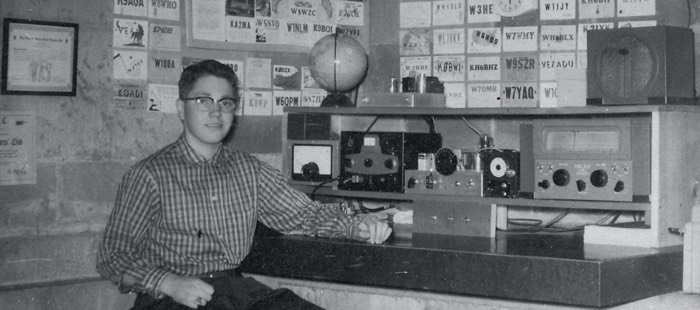 W7ZOI in 1957.
W7ZOI in 1957.
The gear in the above photo is pretty common for a novice, or
post-novice station of the era. The Viking Adventure kit
transmitter was driven by a remotely-tuned VFO built from a
description in the 1954 ARRL Handbook. The receiver is
a four band outgrowth of the "SSB Q-5er," which consisted of a
crystal controlled converter ahead of a BC-453 Command
Receiver. The Novice Q-5er and the SSB Q-5er were
creations of W6TNS as published in CQ Magazine. A
National NC-46 receiver provided general coverage listening in an
era where there was a lot to be heard. My
antennas were simple low dipoles or a vertical of one sort or
another.
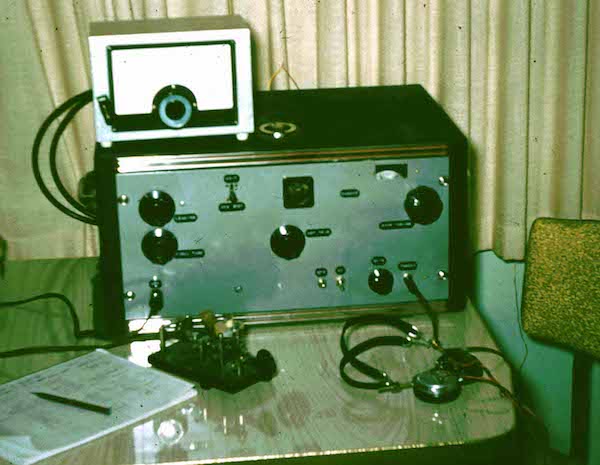 A "portable" station to keep me
on-the-air in 1961.
A "portable" station to keep me
on-the-air in 1961.
The above rig is one I built while in college, under
grad. I knew I was going to be moving from Washington
to California, so I sold my NC-46 and Viking Adventure
Transmitter. I then constructed a station for 40 and
20 meter CW. It ran 90 watts input to a 6146B driven
by a 6AG7. A 5763 was the VFO that used a previously built
remote tuned circuit. Power supplies were built-in. I
eventually demolished part of this rig for parts to be used in a
solid state station, and gave the rest to a fellow I was working
with at the time.
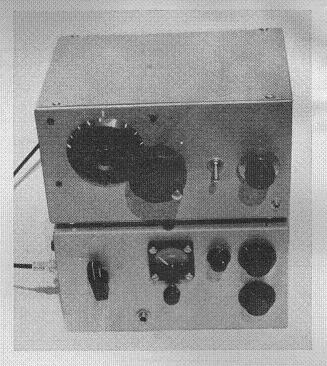 This was the station that was in use by February,
1963. The upper unit is a superhet receiver using 9
Germanium transistors and a half lattice crystal filter. The
bottom unit was a transmitter with an output of 1 watt on 40
meters, crystal controlled. The PA was a pair of
2N696s. A built in 12 volt lantern battery powered the
transmitter. The receiver had it's own 9 volt
battery. Each box was 5x6x9", so it was nearly
portable.
This was the station that was in use by February,
1963. The upper unit is a superhet receiver using 9
Germanium transistors and a half lattice crystal filter. The
bottom unit was a transmitter with an output of 1 watt on 40
meters, crystal controlled. The PA was a pair of
2N696s. A built in 12 volt lantern battery powered the
transmitter. The receiver had it's own 9 volt
battery. Each box was 5x6x9", so it was nearly
portable.
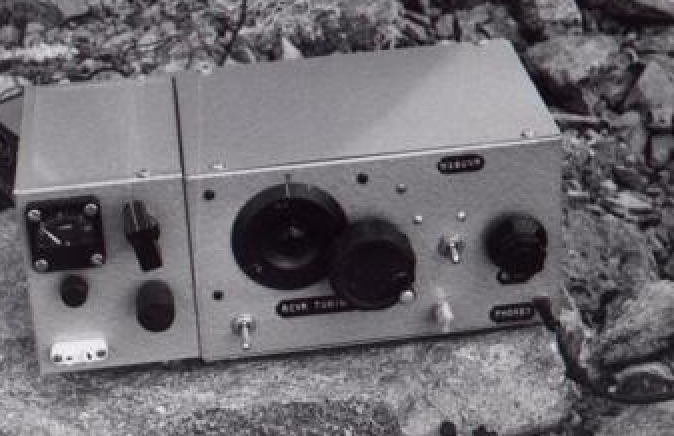 This is the appearance of the same rig
in 1965. The transmitter, now with 3 watts output, is
smaller, but bolted to the receiver. This photo was
taken at a Field Day location at an elevation of 12,000 ft in the
Sierra Nevada Mountains of California.
Eventually the transmitter circuitry was crammed into the receiver
box. That rig was used on a climb of Washington's Mt.
Adams in 1967.
This is the appearance of the same rig
in 1965. The transmitter, now with 3 watts output, is
smaller, but bolted to the receiver. This photo was
taken at a Field Day location at an elevation of 12,000 ft in the
Sierra Nevada Mountains of California.
Eventually the transmitter circuitry was crammed into the receiver
box. That rig was used on a climb of Washington's Mt.
Adams in 1967.
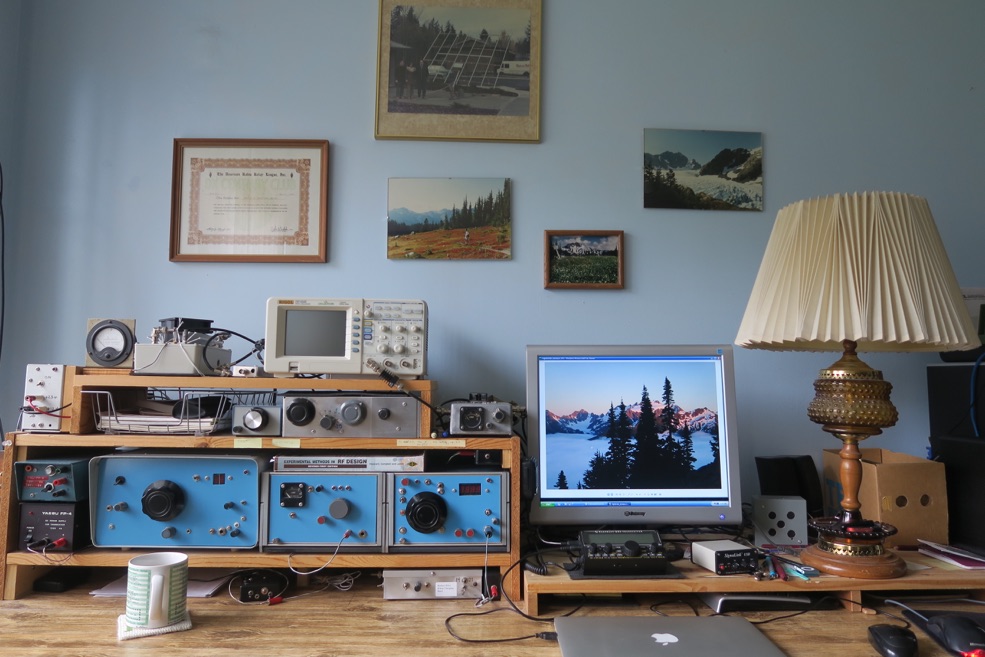
This is the shack as it appeared in January, 2019. The
meter from the 1964/1967 rig is still part of this 2019 station.
The station in 2016 and later generates a power similar to the
Viking Adventure shown above and is still mostly CW, but is now
all solid state. Much of the present station is
homebrew. Click on the station photo below for more
views.
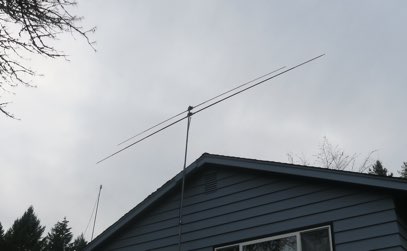
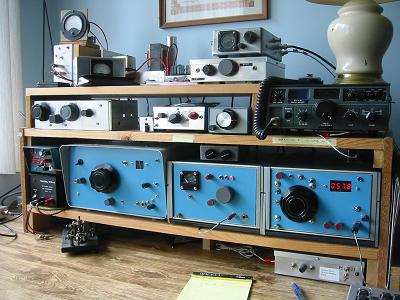 Click photo for more station views.
Click photo for more station views.
The antenna photo shows rotary dipoles for 15 and 10 meters.
This antenna also functions on 17 and 12 meters when a
transmatch is used. The array is 28 ft above ground on a
push-up mast that is rotated by hand.
Our homebrew gear is built in another corner of the
basement. A view of the lab/shop is shown below.
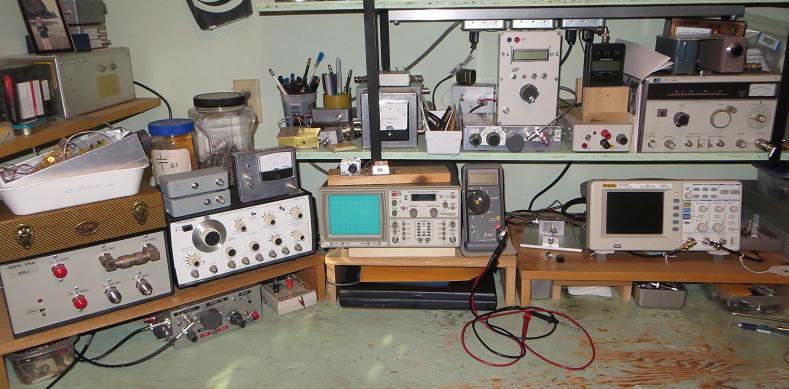 The lab is dynamic in that it changes frequently, depending upon
the experiments being done. The photo shows the main
lab oscilloscope, a Rigol DS1052E. The 'scope
moves between rooms, depending upon the needs. Two spectrum
analyzers and a VNA (N2PK type) are included in the
lab. Out of view we also have an HP4342A
Q-Meter, HP6002A power supply, HP8640B signal generator, and an
old analog Tektronix oscilloscope. We have
recently added a microscope to facilitate SMT work. A
NanoVNA is also in the collection.
The lab is dynamic in that it changes frequently, depending upon
the experiments being done. The photo shows the main
lab oscilloscope, a Rigol DS1052E. The 'scope
moves between rooms, depending upon the needs. Two spectrum
analyzers and a VNA (N2PK type) are included in the
lab. Out of view we also have an HP4342A
Q-Meter, HP6002A power supply, HP8640B signal generator, and an
old analog Tektronix oscilloscope. We have
recently added a microscope to facilitate SMT work. A
NanoVNA is also in the collection.
Some other history.
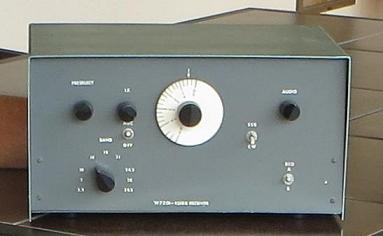 While on a 2013 trip to Florida, we
spent a couple of days with John Lawson, K5IRK, and his wife
Carol. John and I collaborated on a receiver project,
the "Progressive Receiver." (QST, Nov, 1981) Click on
the receiver photo for a shot of John and me with the receiver.
(John is the one with the hair.) John tells me that
the original receiver still works just as it did in 1981.
John replaced all of the electrolytic capacitors to achieve this
status. Guess even our 1981 solid state homebrew
receiver has reached boat-anchor status.
While on a 2013 trip to Florida, we
spent a couple of days with John Lawson, K5IRK, and his wife
Carol. John and I collaborated on a receiver project,
the "Progressive Receiver." (QST, Nov, 1981) Click on
the receiver photo for a shot of John and me with the receiver.
(John is the one with the hair.) John tells me that
the original receiver still works just as it did in 1981.
John replaced all of the electrolytic capacitors to achieve this
status. Guess even our 1981 solid state homebrew
receiver has reached boat-anchor status.
A major ham experience in my past was my
participation in EME. I helped Fred and Susan Telewski,
WA7TZY and WB7BST, with construction of a station for 432 MHz.
I built the 400 MHz LO chain used for the receiver
converter while Fred built several LNAs in that pre-GaAsFET
era. The EME station was first put on the air in
November 23, 1975, so we could work a group at the large dish
at Stanford University. We devoted an all-night session
to the project, finally making a contact at 5
AM. I returned the next morning in daylight
to get a photo of the antenna before it was moved to Fred's
back yard where it did not irritate and confuse the
neighborhood. (The photo below was by Fred.) The
antenna was a 128 element extended expanded co-linear (bed
spring) on a polar mount, an outgrowth of a QST paper by Joe,
W6FZJ. (Remember him?) Great fun -- many thanks
to Fred & Susan.
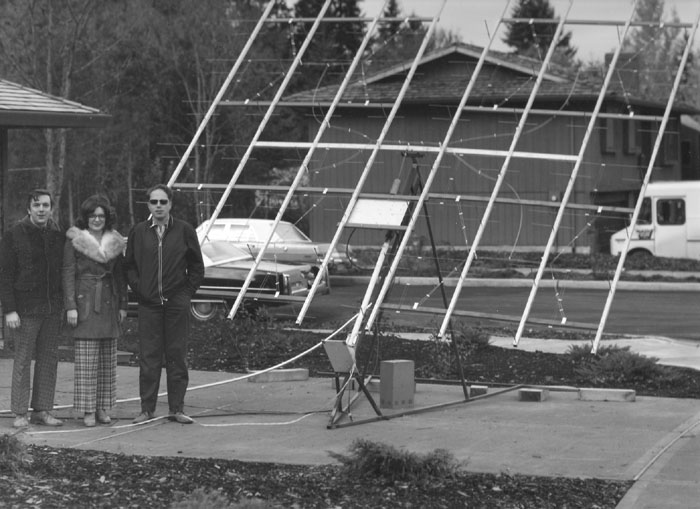 WA7TZY,
WB7BST, and W7ZOI in 1975. I have a color version of
this photo on the wall of my shack.
WA7TZY,
WB7BST, and W7ZOI in 1975. I have a color version of
this photo on the wall of my shack.
 WA7TZY (sk)
WA7TZY (sk)
This photo of Fred
Telewski, WA7TZY, was taken the last time I saw him.
He and Susan met us at a reception at the Seattle Space Needle
in 2013. It was an amateur radio gathering
associated with the IEEE Microwave Theory and Techniques
sponsored International Microwave Symposium. We lost
Fred in the summer of 2020 at age 74 when he died
of complications following heart surgery.
I first met Fred when he joined Tektronix in the early
1970s. Fred was a circuit design engineer in the
spectrum analyzer group. I was also working at Tek, but in
a group called "Display Device Development," far removed
from his world of circuit design. We had a
connection through amateur radio and related writing that we had
both done. (See ref 1 below.) I joined Fred in the
Tek spectrum analyzer group in 1974. Fred and
another ham, Larry Lockwood, W7JBY (sk) were my mentors in this
transition. Fred eventually left Tektronix for
greener pastures, but remained on the west coast. We
stayed in contact and would talk on the telephone a couple of
times per year with our last call only two days before he
entered the hospital for surgery. I'll miss those calls as
well as our occasional QSOs on VHF and above, or personal visits
at meetings in the Northwest. Fredís amateur radio
interests were dominated by VHF and UHF including 432 MHz EME.
Fred preferred EME contacts where the CW signals could be
heard by the operator. In later years his ham
interests moved toward chasing DX on the 160 and 75 meter
bands. Fred's other interests varied from ball
room dancing to color photography, including the color
processing. We'll miss him.
Ref 1. Telewski, Fred, ďA Practical Approach to 432-MHz
SSB,Ē Ham Radio Magazine, June, 1971. This was
followed by a HR paper in Nov. 1971 about a 432 MHz Corner
Reflector antenna.
 W7ZOI in 1957.
W7ZOI in 1957.  A "portable" station to keep me
on-the-air in 1961.
A "portable" station to keep me
on-the-air in 1961. This is the appearance of the same rig
in 1965. The transmitter, now with 3 watts output, is
smaller, but bolted to the receiver. This photo was
taken at a Field Day location at an elevation of 12,000 ft in the
Sierra Nevada Mountains of California.
Eventually the transmitter circuitry was crammed into the receiver
box. That rig was used on a climb of Washington's Mt.
Adams in 1967.
This is the appearance of the same rig
in 1965. The transmitter, now with 3 watts output, is
smaller, but bolted to the receiver. This photo was
taken at a Field Day location at an elevation of 12,000 ft in the
Sierra Nevada Mountains of California.
Eventually the transmitter circuitry was crammed into the receiver
box. That rig was used on a climb of Washington's Mt.
Adams in 1967. 

 The lab is dynamic in that it changes frequently, depending upon
the experiments being done. The photo shows the main
lab oscilloscope, a Rigol DS1052E. The 'scope
moves between rooms, depending upon the needs. Two spectrum
analyzers and a VNA (N2PK type) are included in the
lab. Out of view we also have an HP4342A
Q-Meter, HP6002A power supply, HP8640B signal generator, and an
old analog Tektronix oscilloscope. We have
recently added a microscope to facilitate SMT work. A
NanoVNA is also in the collection.
The lab is dynamic in that it changes frequently, depending upon
the experiments being done. The photo shows the main
lab oscilloscope, a Rigol DS1052E. The 'scope
moves between rooms, depending upon the needs. Two spectrum
analyzers and a VNA (N2PK type) are included in the
lab. Out of view we also have an HP4342A
Q-Meter, HP6002A power supply, HP8640B signal generator, and an
old analog Tektronix oscilloscope. We have
recently added a microscope to facilitate SMT work. A
NanoVNA is also in the collection.  WA7TZY,
WB7BST, and W7ZOI in 1975. I have a color version of
this photo on the wall of my shack.
WA7TZY,
WB7BST, and W7ZOI in 1975. I have a color version of
this photo on the wall of my shack.  WA7TZY (sk)
WA7TZY (sk)